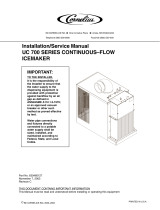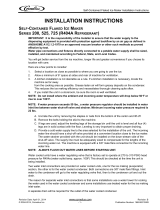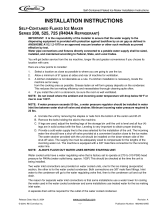
i
630460127
TABLE OF CONTENTS
Page
SAFETY INFORMATION 1....................................................
RECOGNIZE SAFETY INFORMATION 1..................................
UNDERSTAND SIGNAL WORDS 1.......................................
FOLLOW SAFETY INSTRUCTIONS 1....................................
GENERAL DESCRIPTION 3..................................................
TO THE USER OF THIS MANUAL 3.......................................
DESCRIPTION 3........................................................
CLAIMS INSTRUCTIONS 3..............................................
W ARRANTY REFERENCE INFORMATION 3...............................
DESIGN DATA 3........................................................
SPECIFICATION CHART 4...............................................
INSTALLATION 7............................................................
PRE--INSTALLATION 7...................................................
FREIGHT DAMAGE CLAIM 7............................................
COUNTER 7...........................................................
ELECTRICAL 7........................................................
DRAIN 7..............................................................
INSTALLATION 8........................................................
INITIAL START UP, CHECKS AND ADJUSTMENT INSTRUCTIONS 8.........
GUIDE TO SERVICE 11.......................................................
ICEMAKER CLEANING AND SANITIZING PROCEDURES 11.................
MAINTENANCE 11.......................................................
MONTHLY 11...........................................................
QUARTERLY 11........................................................
SEMI--ANNUALLY 12....................................................
WAT ER LEVEL CONTROL 12..............................................
HOW WATER LEVEL CONTROL WORKS 12...............................
PURPOSE 12...........................................................
TO REPLACE WATER LEVEL CONTROL 13...............................
TO REPLACE WATER LEVEL SAFET Y SWITCH 13.........................
REFRIGERATION SYSTEM 13.............................................
REFRIGERATION SYSTEM ADJUSTMENTS 13.............................
EXPANSION VALVE 14...................................................
ADJUSTMENT AND TROUBLESHOOTING 14...............................
CONDENSER MODULATING VALVE 14.....................................
CONDENSER MODULATING VALVE REMOVAL 15..........................
BIN CONTROL 15........................................................
GEARMOTOR 16.........................................................
MOTOR CHECK 16.......................................................
START RELAY 17........................................................
TO REPLACE GEARMOTOR ASSEMBLY 17................................
AUGER AND EXTRUDING HEAD REMOVAL 18.............................
INSTALLATION AND SHAFT SEAL REPLACEMENT 18......................





























